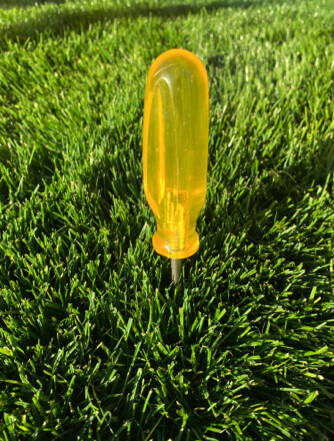Summer is such a wonderful time to enjoy being in your yard! Knowing when, and how much, to water your lawn are the keys to its health and appearance.
Here are some water wise tips for your summer lawn:
The best time to water your lawn is in the early morning to minimize evaporation due to sun or windy conditions. This also gives water time to penetrate deeper into the soil.
Please do not water your established lawn every day! Watering every day encourages plant diseases and shallow roots.
Midday watering, while not harmful to the lawn, is highly inefficient; a large portion of water simply evaporates. Evening or night watering is not ideal either, because it allows the grass blades and thatch to remain wet overnight, creating great potential for disease.
Most established summer lawns need only about 1 inch of water per week. One option is to apply one inch once a week. Another option is to apply one-half of an inch twice a week. This deep watering promotes deep roots.
But how do you know how much is an inch of water? One way is to measure it. Set several straight-walled cans, like cat food or tuna cans, in the area where the sprinklers hit. Then, time how long it takes to fill the majority of containers with one inch of water. Dipping a plastic ruler into the cans is a quick way to take measurements.
Some soils contain more sand while others have higher clay content. That affects how much water the soil can hold and therefore, how much you should water. A simple screwdriver test can help with that.
Push a screwdriver into various places in the soil of your lawn. If you meet a lot of resistance, you may need to water more. If it slides in easily, you probably should water less.
Automatic sprinkler systems are very convenient. Sometimes, they are too convenient! It is important to adjust the settings at least once a month as the watering needs vary greatly throughout the season. Lawns tend to need significantly more water in the mid or late summer as compared to the early summer.
The traditional method of watering with a hose and your sprinkler device of choice continues to be highly effective. This method inherently encourages you to make close observations regarding the lawn’s health.
You can easily determine which areas of your lawn need additional water and which areas will be fine with less water.
More water-wise tips
How you mow your lawn is especially important during the dog days of summer. The first essential thing is to use a mulching mower! This type of mowing chops the grass clippings fine enough so they essentially disappear right into the lawn.
These mulched clippings protect your lawn from high summer heat by helping conserve soil moisture. This grass recycling does not contribute to thatch buildup. As these clippings quickly break down, beneficial nutrients are returned to the soil. Grass recycling contributes about a pound of nitrogen per 1,000 square feet of lawn each year.
The next vital thing is to mow the grass high to encourage strong root growth and heat tolerance. Taller grass provides more shade to the soil and prevents weeds from germinating. Taller grass has a far greater capacity to store water within its blades as compared to shorter grass. So, set your mower to cut grass at 3 inches or even taller.
Your lawn will need less water this way and will have a deeper, greener color! Additionally, grub damage can be significantly reduced or even eliminated simply by mowing the grass high.
Have you noticed that some lawns go completely brown during the dry summer months? Some people intentionally let their lawns go dormant to conserve water. This practice is growing in popularity.
In fact, there is a phrase coined to promote lawns going dormant in the summer; it is “brown is the new green.” Once regular watering stops in the late spring, the grass turns brown. The grass blades dry up and die; however, the crown of the grass can be kept alive with occasional, deep watering.
The crowns of grass must be kept hydrated during dormancy. Typically, the crowns can survive on about one-half inch of water once every two weeks. This way, dormant lawns will be able to green back up when autumn rains stimulate new blade growth.
Being a little more strategic with your summer lawn watering regiment will make a big difference.
For more information about watering your lawn, go to tinyurl.com/SEQgigLawns.
Happy watering!
Dave Eberle is a Clallam County Master Gardener.
Looking after lawns
This is the third article in a series of articles on lawn care that will be published in the Sequim Gazette this year. Look for the next article to spotlight fall lawn care.



